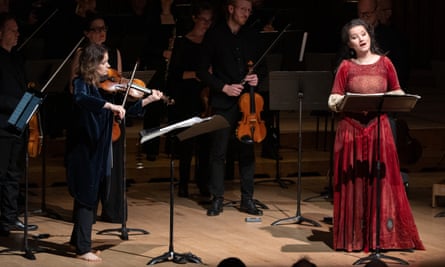Mary the mother of Jesus has been celebrated across many art forms, especially in countless paintings from the middle ages onwards, and in Marian music written by composers of every epoch up to the present. But the other Mary conventionally regarded as having been present at Christ’s crucifixion is a much harder figure to pin down, for across the centuries Mary Magdalene has been seen as one of Christ’s closest friends and followers, as a saint, a muse, and even as a meretrix – the word used for a courtesan in Ancient Rome.
Maria Mater Meretrix, the evening-long sequence of vocal and instrumental pieces devised by Patricia Kopatchinskaja and Anna Prohaska, brings the two Marys together, comparing and contrasting the ways in which they have been depicted across nine centuries of music; a performance with the violinist and soprano joined by Ensemble Resonanz was the last event in the Barbican’s Kopatchinskaja Artist Spotlight series. It’s a thoughtfully put together collection, beautifully paced and presented, and taking in 14 composers, from Hildegard of Bingen to George Crumb and György Kurtág, all performed with stylishness, verve and just a touch of theatricality by these superb artists.

The backbone is provided by Frank Martin’s Maria-Triptychon, an Ave Maria, Magnificat and Stabat Mater dotted through the sequence and much more ambiguous than conventional settings of these famous texts, and all delivered with anguished intensity by Prohaska, while three of Kurtág’s Kafka Fragments for voice and violin have an impact far beyond than their minuscule dimensions. Hanns Eisler’s Lied der Kupplerin, performed, like a number of other pieces, in orchestral arrangements by the composer Michi Wiancko, introduces a hint of Berlin cabaret. Two movements from the orchestral version of Haydn’s Seven Last Words felt slightly out of proportion to the rest, though Il Terremoto, the earthquake movement, provided the evening with a suitably dramatic climax, turned into an anarchic free-for-all by Ensemble Resonanz - with Prohaksa on drums – and preceded by Kopatchinskaja’s own wild Danse Macabre. Finally there was music explicitly concerned with Mary Magdalene – the aria Per il mar del pianto mio, from Caldara’s oratorio Maddalena ai piedi di Cristo; sung with simplicity and great beauty by Prohaska, to wind the recital down to quiet darkness.
Patricia Kopatchinskaja and Anna Prohaska’s recording of Maria Mater Meretrix is now available on Alpha.

Comments (…)
Sign in or create your Guardian account to join the discussion